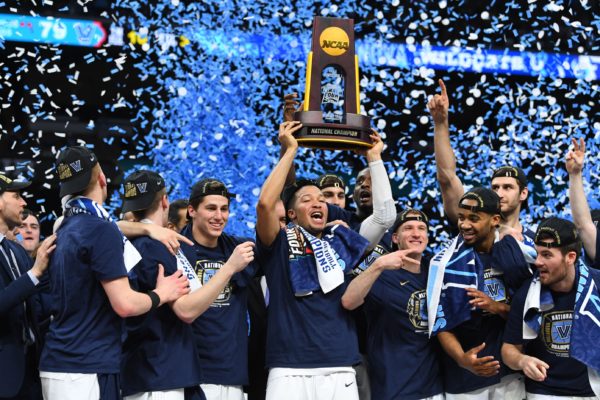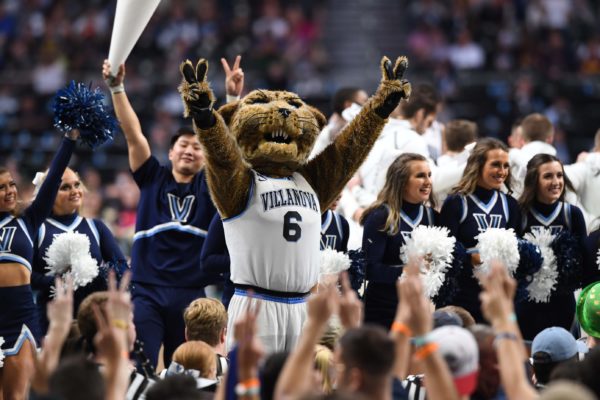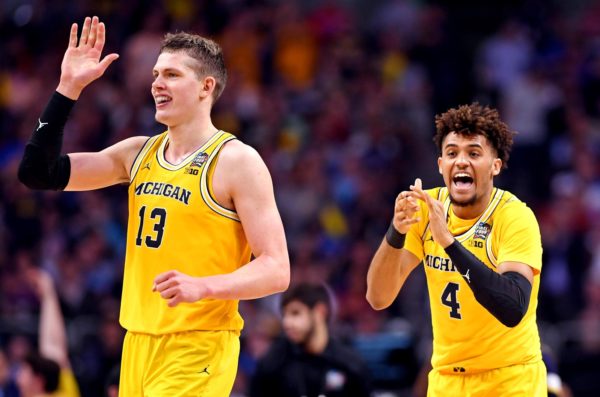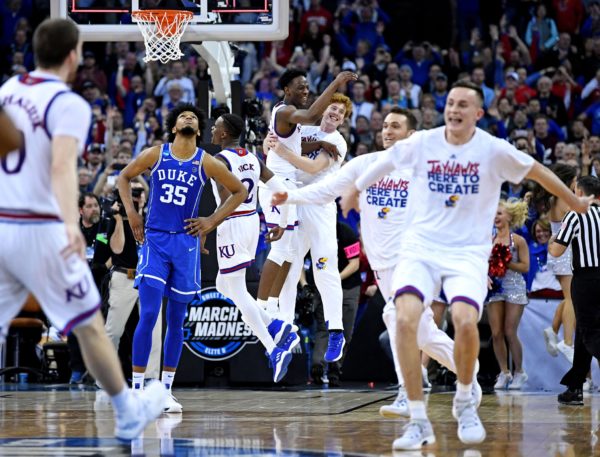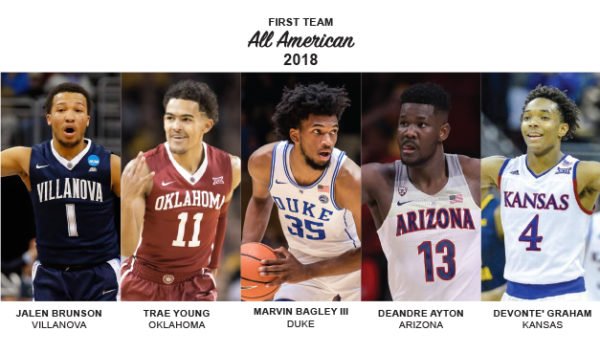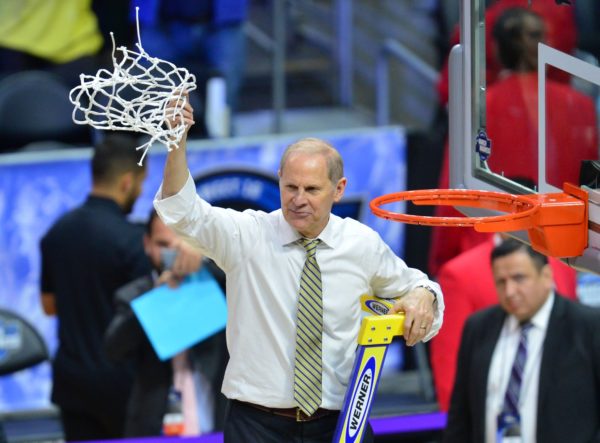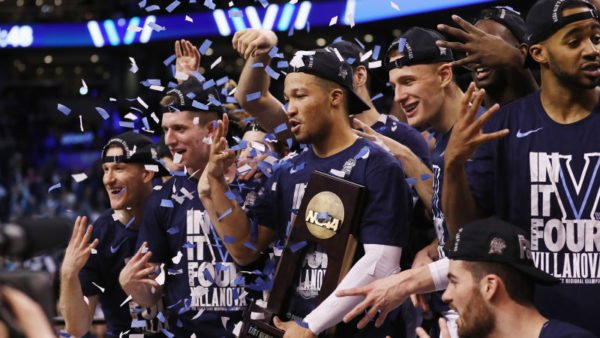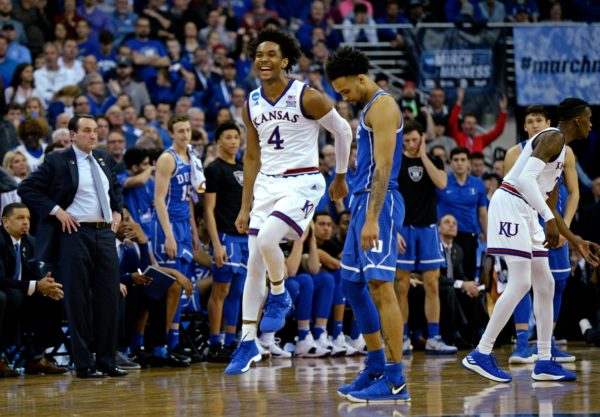Rushed Reactions: #1 Villanova 79, #3 Michigan 62
Posted by rtmsf on April 3rd, 2018RTC will be providing coverage of the NCAA Tournament from start to finish.
Five Key Takeaways.
- Villanova Won the National Title Without All-American Performances From Its All-Americans. NPOY Jalen Brunson and All-American Mikal Bridges have been outstanding all season long, but Michigan managed to give both of them trouble during the key stretches of tonight’s game — essentially, the first half. As Michigan came out swinging haymakers led by the early charge of Moritz Wagner, Brunson and Bridges’ shots that normally drop were rimming out. The pair combined for just 11 first half points on 5-of-14 shooting that included only one three-pointer in six attempts. Luckily for Villanova, a secret weapon came off Jay Wright‘s bench to pick up the slack (more on Donte DiVincenzo below). That gave the Wildcats the cushion they needed heading into the break, allowing for Bridges to join DiVincenzo’s coming-out party in the second half to the tune of 15 points on 5-of-6 shooting. Brunson finished with nine points and two assists on the evening, but that shows just how balanced Villanova was this year — The NPOY had a rough night and his team still won a title game by 17 points.
- Rather, the Michael Jordan of Delaware Stepped Up. To most of America watching tonight, the rise of Donte DiVincenzo to log 31 points and five rebounds on 10-of-15 shooting (5-of-7 3FG) must have seemed like another Grayson Allen moment, where a talented but relatively unknown bench player came out of nowhere to lead his team to the National Championship. The truth, however, is a little more nuanced this time around. Despite being an unheralded recruit out of Wilmington, Delaware (where else?), three years ago, Wright admitted after the game that DiVincenzo was plenty good enough to be his starter on the wing. The wrinkle in the redshirt sophomore coming off the bench is that he still played starter’s minutes (72.5%) this season and logged five games of 20 or more points. He was obviously a key cog all year long, and given Michigan’s defense was so keyed on stopping Brunson and Bridges, DiVincenzo had his chance to step up and he met the call with full throttle.
- Jay Wright Joins Select Company. Not even the most optimistic Villanova fan could have seen this coming a little over two years ago. Jay Wright had experienced so many disappointing NCAA Tournaments since his last run to the Final Four in 2009 that there were some grumblings in Philadelphia about him keeping his job. Two years forward and now Wright is one of only 15 coaches in NCAA history (and two active) to hold more than one National Championship. That he did it with two distinct teams with some overlap perhaps makes it even more impressive. Wright’s 2016 team was certainly outstanding, but it wasn’t a #1 seed nor did it win the Big East Tournament. This group won everything possible — Big East regular season; Big East Tournament; NCAA Tournament — and it did so by demolishing every team in its path during the postseason. Over nine games in the Big East and NCAA Tournaments, the Wildcats won each by an average of 17.7 points per game. Wright is a wonderful narrative in what can happen if a school gives the right coach time to find his own niche and growth curve after some early disappointments.
- Historical Perspective. Not many schools can lay claim to winning two National Championships in a three-year window, and most of those schools won back-to-back titles with largely the same cores. The Kentucky teams of 1996-98 won a pair of titles with vastly different teams (and head coaches). UCLA bookended its 10-in-12 years run of the 1960s and 1970s with similar 2-in-3 successes. Kentucky’s original dynasty had a similar in the early 1950s. But that’s it. What Wright has done at a school that was often considered a second-class Big East citizen behind the likes of Syracuse, UConn and Georgetown is simply phenomenal. Villanova now has more championships than the Orange and Hoyas combined, and is only one behind the Huskies. Conference realignment has hurt a lot of programs in varying ways (hey, Pitt), but perhaps the biggest basketball success story has as a result of all the league movement has occurred right on the Main Line in Philadelphia.
- Basketball Schools Doing Basketball Things. People can quibble about which schools are most closely defined as basketball schools or football schools (and they do), but it’s really not that hard to determine in almost every case. The key question is which sport the fan base tends to most identify with, which in part fuels support and expectations for success in that sport, working in a continuous feedback loop. Villanova defines itself by its basketball program. Michigan — while very successful in both major collegiate sports — most assuredly defines itself on the gridiron. With Villanova’s second title in the last three years tonight, basketball schools have won the last 11 championships and 22 of the last 24 titles. The lone exception during that period was Florida’s back-to-back run in 2006-07. There are plenty of reasons for this kind of run that involves resources, coaching, motivation and luck, but the fact remains that the football schools as a general rule haven’t been able to break through the plexiglass ceiling just yet.
Player of the Game. Donte DiVincenzo, Villanova. DiVincenzo produced one of the best championship game performances in modern college basketball history tonight, dropping 31 points, five rebounds and three assists on 10-of-15 shooting. He also nailed five back-breaking threes (in seven attempts), two of which came in succession when Villanova earned the lead for good and wrested control of the game away from Michigan. Per the NCAA, DiVincenzo’s effort represented just the sixth time in the last 40 years when a player in the title game has topped the 30-point barrier. That he did so from the bench makes it even more impressive.
30-point games in championship game history in last 40 years: Jack Givens (41 for Kentucky in'78), Danny Manning (31 for Kansas in '88), John Morton (35 for Seton Hall in '89), Ed O'Bannon (30 for UCLA in '95), Miles @milessimon (30 for Arizona in '97). DiVincenzo sitting at 29.
— David Worlock (@DavidWorlock) April 3, 2018





























